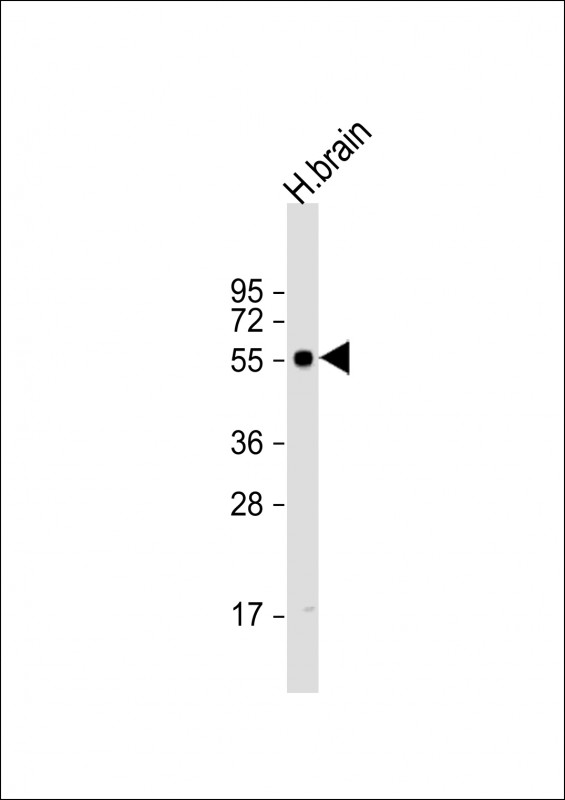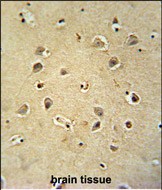GABRG2 Antibody (Center)
Affinity Purified Rabbit Polyclonal Antibody (Pab)
- SPECIFICATION
- CITATIONS
- PROTOCOLS
- BACKGROUND

Application
| WB, IHC-P, E |
|---|---|
| Primary Accession | P18507 |
| Other Accession | P18508, P22723, P22300, NP_000807.2 |
| Reactivity | Human, Mouse |
| Predicted | Bovine, Rat |
| Host | Rabbit |
| Clonality | Polyclonal |
| Isotype | Rabbit IgG |
| Calculated MW | 55186 Da |
| Antigen Region | 198-224 aa |
| Gene ID | 2566 |
|---|---|
| Other Names | Gamma-aminobutyric acid receptor subunit gamma-2, GABA(A) receptor subunit gamma-2, GABRG2 |
| Target/Specificity | This GABRG2 antibody is generated from rabbits immunized with a KLH conjugated synthetic peptide between 198-224 amino acids from the Central region of human GABRG2. |
| Dilution | WB~~1:1000 IHC-P~~1:50~100 E~~Use at an assay dependent concentration. |
| Format | Purified polyclonal antibody supplied in PBS with 0.09% (W/V) sodium azide. This antibody is purified through a protein A column, followed by peptide affinity purification. |
| Storage | Maintain refrigerated at 2-8°C for up to 2 weeks. For long term storage store at -20°C in small aliquots to prevent freeze-thaw cycles. |
| Precautions | GABRG2 Antibody (Center) is for research use only and not for use in diagnostic or therapeutic procedures. |
| Name | GABRG2 (HGNC:4087) |
|---|---|
| Function | Gamma subunit of the heteropentameric ligand-gated chloride channel gated by gamma-aminobutyric acid (GABA), a major inhibitory neurotransmitter in the brain (PubMed:14993607, PubMed:16412217, PubMed:23909897, PubMed:2538761, PubMed:25489750, PubMed:27864268, PubMed:29950725, PubMed:30602789). GABA-gated chloride channels, also named GABA(A) receptors (GABAAR), consist of five subunits arranged around a central pore and contain GABA active binding site(s) located at the alpha and beta subunit interface(s) (PubMed:29950725, PubMed:30602789). When activated by GABA, GABAARs selectively allow the flow of chloride anions across the cell membrane down their electrochemical gradient (PubMed:14993607, PubMed:16412217, PubMed:2538761, PubMed:27864268, PubMed:29950725, PubMed:30602789). Gamma-2/GABRG2-containing GABAARs are found at both synaptic and extrasynaptic sites (By similarity). Chloride influx into the postsynaptic neuron following GABAAR opening decreases the neuron ability to generate a new action potential, thereby reducing nerve transmission (By similarity). GABAARs containing alpha-1 and beta-2 or -3 subunits exhibit synaptogenic activity; the gamma-2 subunit being necessary but not sufficient to induce rapid synaptic contacts formation (PubMed:23909897, PubMed:25489750). Extrasynaptic gamma-2- containing receptors contribute to the tonic GABAergic inhibition (By similarity). GABAARs function also as histamine receptor where histamine binds at the interface of two neighboring beta subunits and potentiates GABA response in a gamma-2 subunit-controlled manner (By similarity). |
| Cellular Location | Postsynaptic cell membrane; Multi-pass membrane protein {ECO:0000269|PubMed:30602789, ECO:0007744|PDB:6I53}. Cell membrane; Multi-pass membrane protein {ECO:0000269|PubMed:30602789, ECO:0007744|PDB:6I53} Cell projection, dendrite {ECO:0000250|UniProtKB:P22723}. Cytoplasmic vesicle membrane {ECO:0000250|UniProtKB:P18508} |

Thousands of laboratories across the world have published research that depended on the performance of antibodies from Abcepta to advance their research. Check out links to articles that cite our products in major peer-reviewed journals, organized by research category.
info@abcepta.com, and receive a free "I Love Antibodies" mug.
Provided below are standard protocols that you may find useful for product applications.
Background
This gene encodes a gamma-aminobutyric acid (GABA) receptor. GABA is the major inhibitory neurotransmitter in the mammlian brain, where it acts at GABA-A receptors, which are ligand-gated chloride channels. GABA-A receptors are pentameric, consisting of proteins from several subunit classes: alpha, beta, gamma, delta and rho. Mutations in this gene have been associated with epilepsy and febrile seizures. Multiple transcript variants encoding different isoforms have been identified for this gene.
References
Green, E.K., et al. Am. J. Med. Genet. B Neuropsychiatr. Genet. 153B (7), 1347-1349 (2010) :
Jansen, L.A., et al. Epilepsia 51(8):1456-1467(2010)
Pinheiro, A.P., et al. Am. J. Med. Genet. B Neuropsychiatr. Genet. 153B (5), 1070-1080 (2010) :
Shi, X., et al. J. Hum. Genet. 55(6):375-378(2010)
Kumari, R., et al. Seizure 19(4):237-241(2010)
If you have used an Abcepta product and would like to share how it has performed, please click on the "Submit Review" button and provide the requested information. Our staff will examine and post your review and contact you if needed.
If you have any additional inquiries please email technical services at tech@abcepta.com.













 Foundational characteristics of cancer include proliferation, angiogenesis, migration, evasion of apoptosis, and cellular immortality. Find key markers for these cellular processes and antibodies to detect them.
Foundational characteristics of cancer include proliferation, angiogenesis, migration, evasion of apoptosis, and cellular immortality. Find key markers for these cellular processes and antibodies to detect them. The SUMOplot™ Analysis Program predicts and scores sumoylation sites in your protein. SUMOylation is a post-translational modification involved in various cellular processes, such as nuclear-cytosolic transport, transcriptional regulation, apoptosis, protein stability, response to stress, and progression through the cell cycle.
The SUMOplot™ Analysis Program predicts and scores sumoylation sites in your protein. SUMOylation is a post-translational modification involved in various cellular processes, such as nuclear-cytosolic transport, transcriptional regulation, apoptosis, protein stability, response to stress, and progression through the cell cycle. The Autophagy Receptor Motif Plotter predicts and scores autophagy receptor binding sites in your protein. Identifying proteins connected to this pathway is critical to understanding the role of autophagy in physiological as well as pathological processes such as development, differentiation, neurodegenerative diseases, stress, infection, and cancer.
The Autophagy Receptor Motif Plotter predicts and scores autophagy receptor binding sites in your protein. Identifying proteins connected to this pathway is critical to understanding the role of autophagy in physiological as well as pathological processes such as development, differentiation, neurodegenerative diseases, stress, infection, and cancer.




